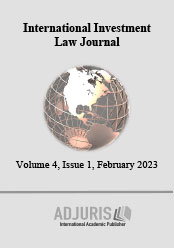Increasing Legal Certainty for Cross - Border Investments by Making National Insolvency Procedures More Efficient and Effective
Increasing Legal Certainty for Cross - Border Investments by Making National Insolvency Procedures More Efficient and Effective
Author(s): Ionel Didea, Diana Maria IlieSubject(s): Supranational / Global Economy, International Law, Economic policy, International relations/trade
Published by: EDITURA ASE
Keywords: cross-border insolvency; trans-disciplinary vision; socio-economic analysis; cross-border investments; integration; harmonization and legislative innovation; global practices;
Summary/Abstract: We have proposed to carry out this article starting from the premise of a transdisciplinary research, reflecting an analysis of insolvency law as “metamorphosed” by the conglomerate of social, economic and political elements and events, which, in reality, permanently “roll” this “legislative snowball” found in the dynamics of globalization and Europeanization, context in which the classical branches of law are resized by acquiring mixed characteristics. The penetration into the realm of transdisciplinarity reflects nothing but the need to adapt the norms of law to the diversity and dynamism of developments, “mutations” and global challenges. The core of our research concerns insolvency law, a law that has reached the stage of remodeling in a global economic context, being permanently ”imprinted” by international and regional legal instruments. Enjoying a “thirsty” field of accelerated reform, we will try to synthesize legislative novelties such as the proposal of EU Directive on the harmonisation of certain aspects of insolvency law and we will explore restructuring benchmarks in the USA, India, Dominican Republic or Saudi Arabia, with often “crossed” visions on insolvency regimes, in order to outline the international picture of the restructuring market in 2023 but also the prospects for 2024, in the idea of identifying coherent measures capable of mitigating the socio-economic consequences at the intersection of contemporary crises, crises that have profoundly changed the approach of the insolvency field. Last but not least, we will stop at one of the key dimensions of the new directive on the EU agenda, namely the creation of a special insolvency legal regime for SMEs, already outlined internationally by UNCITRAL. Beyond the draft directive still on the negotiating table and uncertainties, an initiative that is part of the Commission’s priority objective of strengthening the capital markets union (CMU) with the motto “Make the outcome of cross-border investments more predictable in terms of insolvency proceedings”, beyond the effervescence of international and European insolvency legal instruments, we must reflect on the importance of divergences in the regulatory approach to insolvency as an obstacle to cross-border investments, a firm concern and commitment being needed in order to harmonize legislation and streamline national insolvency procedures insolvency. Let us not forget that effective and harmonised insolvency rules support efficient capital allocation, economic recovery from recessions and therefore economic growth in each country, with insolvency being a key criterion for cross-border investors.
Journal: International Investment Law Journal
- Issue Year: 4/2024
- Issue No: 1
- Page Range: 30-70
- Page Count: 41
- Language: English

